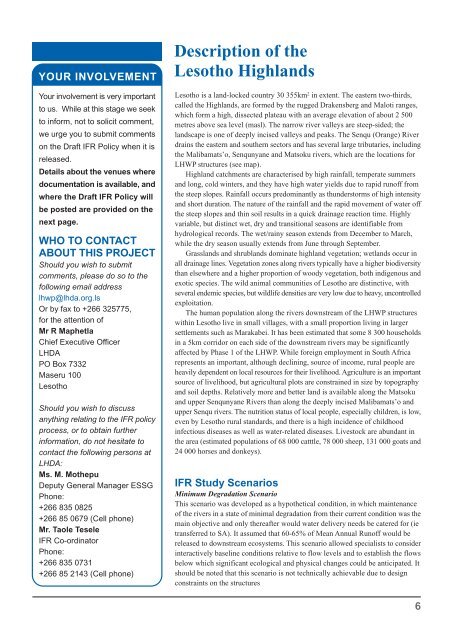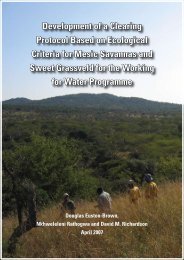INFORMATION DOCUMENT - DWA Home Page
INFORMATION DOCUMENT - DWA Home Page
INFORMATION DOCUMENT - DWA Home Page
Create successful ePaper yourself
Turn your PDF publications into a flip-book with our unique Google optimized e-Paper software.
YOUR INVOLVEMENT<br />
Your involvement is very important<br />
to us. While at this stage we seek<br />
to inform, not to solicit comment,<br />
we urge you to submit comments<br />
on the Draft IFR Policy when it is<br />
released.<br />
Details about the venues where<br />
documentation is available, and<br />
where the Draft IFR Policy will<br />
be posted are provided on the<br />
next page.<br />
WHO TO CONTACT<br />
ABOUT THIS PROJECT<br />
Should you wish to submit<br />
comments, please do so to the<br />
following email address<br />
lhwp@lhda.org.ls<br />
Or by fax to +266 325775,<br />
for the attention of<br />
Mr R Maphetla<br />
Chief Executive Officer<br />
LHDA<br />
PO Box 7332<br />
Maseru 100<br />
Lesotho<br />
Should you wish to discuss<br />
anything relating to the IFR policy<br />
process, or to obtain further<br />
information, do not hesitate to<br />
contact the following persons at<br />
LHDA:<br />
Ms. M. Mothepu<br />
Deputy General Manager ESSG<br />
Phone:<br />
+266 835 0825<br />
+266 85 0679 (Cell phone)<br />
Mr. Taole Tesele<br />
IFR Co-ordinator<br />
Phone:<br />
+266 835 0731<br />
+266 85 2143 (Cell phone)<br />
Description of the<br />
Lesotho Highlands<br />
Lesotho is a land-locked country 30 355km 2 in extent. The eastern two-thirds,<br />
called the Highlands, are formed by the rugged Drakensberg and Maloti ranges,<br />
which form a high, dissected plateau with an average elevation of about 2 500<br />
metres above sea level (masl). The narrow river valleys are steep-sided; the<br />
landscape is one of deeply incised valleys and peaks. The Senqu (Orange) River<br />
drains the eastern and southern sectors and has several large tributaries, including<br />
the Malibamats’o, Senqunyane and Matsoku rivers, which are the locations for<br />
LHWP structures (see map).<br />
Highland catchments are characterised by high rainfall, temperate summers<br />
and long, cold winters, and they have high water yields due to rapid runoff from<br />
the steep slopes. Rainfall occurs predominantly as thunderstorms of high intensity<br />
and short duration. The nature of the rainfall and the rapid movement of water off<br />
the steep slopes and thin soil results in a quick drainage reaction time. Highly<br />
variable, but distinct wet, dry and transitional seasons are identifiable from<br />
hydrological records. The wet/rainy season extends from December to March,<br />
while the dry season usually extends from June through September.<br />
Grasslands and shrublands dominate highland vegetation; wetlands occur in<br />
all drainage lines. Vegetation zones along rivers typically have a higher biodiversity<br />
than elsewhere and a higher proportion of woody vegetation, both indigenous and<br />
exotic species. The wild animal communities of Lesotho are distinctive, with<br />
several endemic species, but wildlife densities are very low due to heavy, uncontrolled<br />
exploitation.<br />
The human population along the rivers downstream of the LHWP structures<br />
within Lesotho live in small villages, with a small proportion living in larger<br />
settlements such as Marakabei. It has been estimated that some 8 300 households<br />
in a 5km corridor on each side of the downstream rivers may be significantly<br />
affected by Phase 1 of the LHWP. While foreign employment in South Africa<br />
represents an important, although declining, source of income, rural people are<br />
heavily dependent on local resources for their livelihood. Agriculture is an important<br />
source of livelihood, but agricultural plots are constrained in size by topography<br />
and soil depths. Relatively more and better land is available along the Matsoku<br />
and upper Senqunyane Rivers than along the deeply incised Malibamats’o and<br />
upper Senqu rivers. The nutrition status of local people, especially children, is low,<br />
even by Lesotho rural standards, and there is a high incidence of childhood<br />
infectious diseases as well as water-related diseases. Livestock are abundant in<br />
the area (estimated populations of 68 000 catttle, 78 000 sheep, 131 000 goats and<br />
24 000 horses and donkeys).<br />
IFR Study Scenarios<br />
Minimum Degradation Scenario<br />
This scenario was developed as a hypothetical condition, in which maintenance<br />
of the rivers in a state of minimal degradation from their current condition was the<br />
main objective and only thereafter would water delivery needs be catered for (ie<br />
transferred to SA). It assumed that 60-65% of Mean Annual Runoff would be<br />
released to downstream ecosystems. This scenario allowed specialists to consider<br />
interactively baseline conditions relative to flow levels and to establish the flows<br />
below which significant ecological and physical changes could be anticipated. It<br />
should be noted that this scenario is not technically achievable due to design<br />
constraints on the structures<br />
6
















